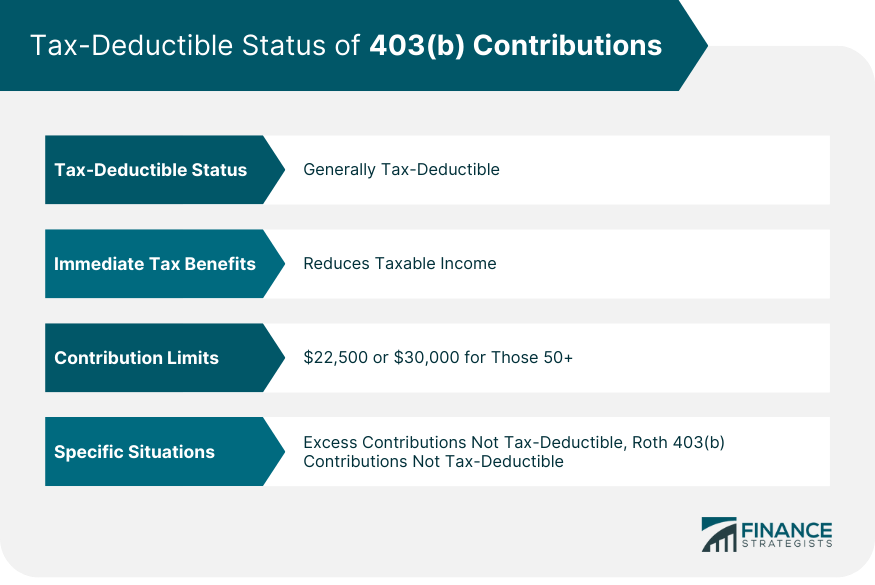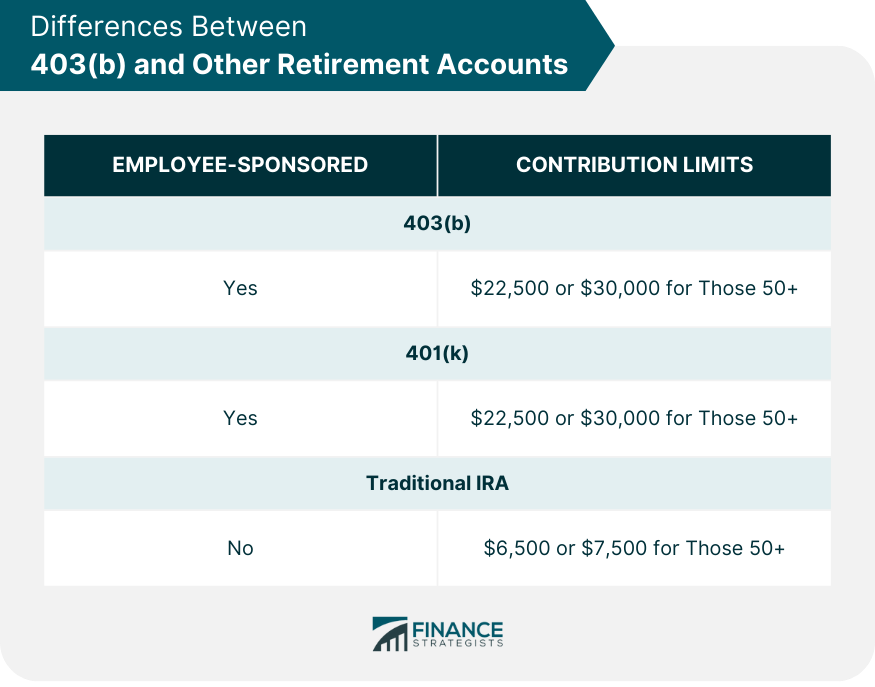A 403(b) plan is a tax-advantaged retirement savings plan available for specific employees of public schools, tax-exempt organizations, and certain ministers. These employees can set aside a portion of their salary for retirement savings, effectively reducing their taxable income. The primary aim is to encourage long-term savings and provide a nest egg for employees in their retirement years. The purpose of a 403(b) plan, like other retirement savings plans, is to provide a platform for employees to save and invest for their retirement while receiving tax benefits. It is a type of defined contribution plan that allows employees to contribute a portion of their salary toward retirement savings. The tax benefits come in the form of tax-deferred growth and the possibility of tax-deductible contributions. Contributions made to a 403(b) plan are generally tax-deductible, meaning that they reduce the amount of income that is subject to tax in the year the contribution is made. These contributions are made on a pre-tax basis, which means that the money goes into the 403(b) plan before income taxes are deducted. However, the funds and any earnings grow tax-deferred until withdrawn. The immediate tax benefit of 403(b) contributions is a reduction in taxable income. When contributions are made into the 403(b) account, they are subtracted from the gross income, reducing the amount of income subject to tax. This implies that if an employee has a gross income of $75,000 and contributes $15,000 to a 403(b) plan, their taxable income for the year would be $60,000. For 403(b) plans, the Internal Revenue Service (IRS) imposes annual contribution limits that affect the amount of tax deduction that can be claimed. In 2024, for instance, an individual can contribute $23,000 or $30,500 if age 50 or older. Contributions exceeding the limit are not tax-deductible and could be subject to penalties. While contributions to a 403(b) plan are generally tax-deductible, there are some situations where they may not be. For instance, if contributions exceed the IRS limit for the year, the excess amount will not be deductible. Additionally, contributions made to a Roth 403(b), a subset of the 403(b) plan, are not tax-deductible as these are made with after-tax dollars. The advantage of a Roth 403(b), however, is that qualified withdrawals in retirement are tax-free. When an employee makes contributions to a 403(b) plan, those contributions are subtracted from their salary before taxes are applied, effectively lowering their taxable income for that year. For example, if an employee earns $50,000 in a year and contributes $5,000 to their 403(b) plan, their taxable income for that year would be reduced to $45,000. Therefore, the tax deduction effectively lowers the employee's income tax liability for that year. Both employee and employer contributions to a 403(b) plan can be advantageous from a tax perspective. Employee contributions reduce taxable income, lowering the current tax liability, while employer contributions are not included as taxable income at all. However, it's important to note that employer contributions might have vesting schedules that employees need to fulfill before gaining complete ownership of those funds. Tax deductions for 403(b) contributions are typically straightforward. Since the contributions are made with pre-tax dollars, they automatically reduce your taxable income. Therefore, the contributions are not reported as a tax deduction on your tax return like you would with a traditional IRA contribution. Instead, the contributions and your taxable income are reported correctly on your W-2 form, which you receive from your employer. The W-2 form is a critical document that reports an employee's annual wages and the amount of taxes withheld from their paycheck. In relation to 403(b) contributions, the W-2 form shows the taxable income after the contributions have been made. The contributions to the 403(b) plan are reported in box 12 of the W-2 form with the code "E." This indicates the amount of pre-tax contributions an employee has made over the year. Though 403(b), 401(k), and IRA are all retirement savings vehicles, they have distinct differences, including their tax treatment. Both 403(b) and 401(k) plans are employer-sponsored retirement plans that allow pre-tax contributions, reducing taxable income in the year of contribution. Contributions grow tax-deferred, and withdrawals are taxed as ordinary income. On the other hand, an Individual Retirement Account (IRA) can be set up by anyone, irrespective of their employment status. Traditional IRAs allow pre-tax contributions if certain conditions are met and the contributions grow tax-deferred. However, contribution limits for IRAs are lower than those for 403(b) and 401(k) plans. In a 403(b) and 401(k) plan, tax advantages include the immediate tax deduction on contributions and tax-deferred growth of investments. However, withdrawals during retirement are taxed as regular income. Also, these plans come with higher contribution limits compared to an IRA. With a traditional IRA, contributions are tax-deductible based on income limits, and investments grow tax-deferred. Withdrawals in retirement are taxed as ordinary income. The disadvantage is that contribution limits are significantly lower than 403(b) or 401(k) plans. Also, high-income earners may not be able to deduct their IRA contributions if they or their spouse have access to a workplace retirement plan. Choosing between different retirement accounts often depends on individual financial situations, retirement goals, and access to employer-sponsored plans. Key considerations should include the individual's tax situation, the need for immediate tax deductions, the availability of employer match contributions, income limits, and contribution limits. Withdrawals from a 403(b) plan are generally subject to ordinary income tax rates. If contributions were made pre-tax, the entire amount of the withdrawal is taxable. If the 403(b) is a Roth account, qualified withdrawals of contributions and earnings are tax-free. However, non-qualified withdrawals may be subject to taxes and penalties. Taking distributions from a 403(b) plan before the age of 59½ typically triggers a 10% early withdrawal penalty in addition to income taxes. However, there are several exceptions to this rule. For instance, the penalty may be waived in cases of severe financial hardship, disability, or the account holder's death. Furthermore, individuals who leave their job in the year they turn 55 or later can also take penalty-free withdrawals. Required Minimum Distributions (RMDs) are mandatory withdrawals that must be taken from 403(b) plans to start at age 72 (or 73 if you reach age 72 after Dec. 31, 2022). The exact amount of the RMD depends on the account balance and the account holder's age. These distributions are subject to ordinary income tax. Failure to take the RMD results in a significant tax penalty, amounting to 50% of the amount that should have been withdrawn. Contributions made to a 403(b) plan are generally tax-deductible, reducing your taxable income in the year of contribution. However, there are limits to the amounts that can be contributed and thus deducted in a given year. Additionally, not all contributions, such as those to a Roth 403(b), are tax-deductible. Proper tax planning plays a crucial role in maximizing your retirement savings. Understanding the tax advantages of various retirement accounts and the potential tax implications of withdrawals can help you strategize effectively, potentially growing your retirement nest egg more significantly over time. Consulting with a financial advisor or tax professional is strongly recommended to ensure that your retirement planning aligns with your overall financial goals.Overview of 403(b) Plans
Are 403(b) Contributions Tax Deductible?
Tax-Deductible Status of 403(b) Contributions
Immediate Tax Benefits for Contributions
Impact of Contribution Limit on Tax Deduction
Specific Situations Where Contributions May Not Be Tax Deductible

Mechanics of 403(b) Tax Deductions
How Tax Deductions Work for a 403(b) Plan
Role of Employer and Employee Contributions
How to Claim Tax Deductions for 403(b) Contributions
Understanding the W-2 Form in Relation to 403(b) Contributions
Differences Between 403(b) and Other Retirement Accounts
Comparisons Between 403(b), 401(k), and IRA Contributions
Tax Advantages and Disadvantages of Each Type of Account
Considerations When Choosing Between Retirement Account Types

Potential Tax Implications When Withdrawing From a 403(b) Plan
Tax Treatment of Withdrawals From a 403(b)
Penalties for Early Withdrawal and Exceptions
Required Minimum Distributions (RMDs) and Their Tax Implications
The Bottom Line
Are 403(b) Contributions Tax Deductible? FAQs
Yes, contributions to a 403(b) plan are generally tax-deductible, reducing your taxable income in the year of the contribution.
Like a 401(k), a 403(b) plan is an employer-sponsored plan that allows for higher contribution limits than an IRA. Contributions are made pre-tax and grow tax-deferred until retirement, at which point withdrawals are taxed as regular income.
Withdrawals from a 403(b) plan are typically taxed as ordinary income. Early withdrawals (before age 59½) may also incur a 10% penalty, though there are exceptions.
RMDs are mandatory withdrawals that must be taken from a 403(b) plan starting at age 72. These distributions are taxed as ordinary income.
Factors such as your tax situation, the need for immediate tax deductions, the availability of employer match contributions, income limits, and contribution limits should all be taken into account.
True Tamplin is a published author, public speaker, CEO of UpDigital, and founder of Finance Strategists.
True is a Certified Educator in Personal Finance (CEPF®), author of The Handy Financial Ratios Guide, a member of the Society for Advancing Business Editing and Writing, contributes to his financial education site, Finance Strategists, and has spoken to various financial communities such as the CFA Institute, as well as university students like his Alma mater, Biola University, where he received a bachelor of science in business and data analytics.
To learn more about True, visit his personal website or view his author profiles on Amazon, Nasdaq and Forbes.















